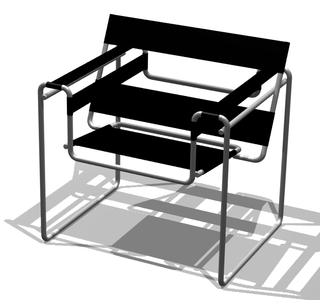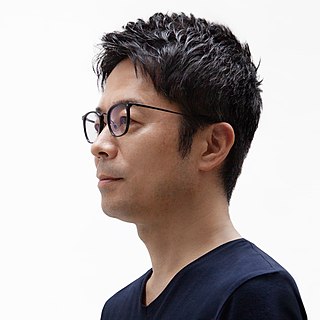Related Research Articles

Furniture refers to objects intended to support various human activities such as seating, eating (tables), storing items, working, and sleeping. Furniture is also used to hold objects at a convenient height for work, or to store things. Furniture can be a product of design and can be considered a form of decorative art. In addition to furniture's functional role, it can serve a symbolic or religious purpose. It can be made from a vast multitude of materials, including metal, plastic, and wood. Furniture can be made using a variety of woodworking joints which often reflects the local culture.

Cooper Hewitt, Smithsonian Design Museum is a design museum housed within the Andrew Carnegie Mansion in Manhattan, New York City, along the Upper East Side's Museum Mile. It is one of 19 museums that operate within the Smithsonian Institution and is one of three Smithsonian facilities located in New York City, the other two being the National Museum of the American Indian's George Gustav Heye Center in Bowling Green and the Archives of American Art New York Research Center in the Flatiron District. Unlike other Smithsonian museums, Cooper Hewitt is not free to the public and charges an admissions fee to visitors. It is the only museum in the United States devoted to historical and contemporary design. Its collections and exhibitions explore approximately 240 years of design aesthetic and creativity.

Florence Marguerite Knoll Bassett was an American architect, interior designer, furniture designer, and entrepreneur who has been credited with revolutionizing office design and bringing modernist design to office interiors. Knoll and her husband, Hans Knoll, built Knoll Associates into a leader in the fields of furniture and interior design. She worked to professionalize the field of interior design, fighting against gendered stereotypes of the decorator. She is known for her open office designs, populated with modernist furniture and organized rationally for the needs of office workers. Her modernist aesthetic was known for clean lines and clear geometries that were humanized with textures, organic shapes, and colour.

Knoll is an American company that manufactures office systems, seating, storage systems, tables, desks, textiles, as well as accessories for the home, office, and higher education. The company is the licensed manufacturer of furniture designed by notable architects and designers such as David Adjaye, Harry Bertoia, Ludwig Mies van der Rohe, Florence Knoll, Frank Gehry, Charles Gwathmey, Maya Lin, Marc Newson, Ini Archibong, Eero Saarinen, and Lella and Massimo Vignelli, under the company's KnollStudio division. Over 40 Knoll designs can be found in the permanent design collection of the Museum of Modern Art in New York City.

Dorothy Wright Liebes was an American textile designer and weaver renowned for her innovative, custom-designed modern fabrics for architects and interior designers. She was known as "the mother of modern weaving".
JB Blunk (1926–2002) was a sculptor who worked primarily in wood and clay. In addition to the pieces he produced in wood and ceramics, Blunk worked in other media, including jewelry, furniture, painting, bronze, and stone.

Scott Burton was an American sculptor and performance artist best known for his large-scale furniture sculptures in granite and bronze.

A stool is a raised seat commonly supported by three or four legs, but with neither armrests nor a backrest, and typically built to accommodate one occupant. As some of the earliest forms of seat, stools are sometimes called backless chairs despite how some modern stools have backrests. Folding stools can be collapsed into a flat, compact form typically by rotating the seat in parallel with fold-up legs.

Tokujin Yoshioka is a Japanese designer and artist.
Jhane Barnes is an American designer of clothing, textiles, eyeglasses, carpets and furniture, and the owner of the Jhane Barnes fashion design company. Barnes is known for incorporating complex, mathematical patterns into her clothing designs. She uses computer software to design textile patterns, which then translates the patterns into jacquard loom instructions, which are sent to mills to be woven into fabric.
Molo Design Limited, stylized as molo, is a multidisciplinary design and production studio based in Vancouver, British Columbia, Canada led by Stephanie Forsythe and Todd MacAllen. The studio integrates the practices of architecture, craft, and product design. molo products develop from Forsythe and MacAllen's materials research and studies.

Trude Guermonprez, born Gertrud Emilie Jalowetz, was a German]-born American textile artist, designer and educator, known for her tapestry landscapes. Her Bauhaus-influenced disciplined abstraction for hand woven textiles greatly contributed to the American craft and fiber art movements of the 1950s, 60s and even into the 70s, particularly during her tenure at the California College of Arts and Crafts.

Eszter Haraszty was a Hungarian-born designer best known for her work as head of the textiles department at Knoll.
Dakota Jackson is an American furniture designer known for his eponymous furniture brand, Dakota Jackson, Inc., his early avant-garde works involving moving parts or hidden compartments, and his collaborations with the Steinway & Sons piano company.
Lia Cook is an American fiber artist noted for her work combining weaving with photography, painting, and digital technology. She lives and works in Berkeley, California, and is known for her weavings which expanded the traditional boundaries of textile arts. She has been a professor at California College of the Arts since 1976.
Max Lamb is a British furniture designer who combines traditional, often primitive, design methods with digital design. He is known for employing unusual approaches to using natural materials, including pouring pewter onto sand, and volcanic rock.

Ruud-Jan Kokke is a Dutch designer who started his career in the mid-eighties and became known for his furniture, inventive objects, interiors and designs for public space. He has received numerous nominations and awards. He is married to the visual artist and jewellery designer Petra Hartman.
softwall is a flexible room divider designed by Stephanie Forsythe and Todd MacAllen of molo. Made from paper or nonwoven polyethylene, the walls use a structured honeycomb geometry to bend, curve, expand and contract. The honeycomb structure also provides acoustic absorption. Part of a modular system, each softwall can connect to another by magnetic end panels. The walls have been used to create booths for trade fairs, pop-up retail, sculptural art installations, backdrops for performances, as well as to divide space in living and working environments.
Folayemi "Fo" Debra Wilson is an American interdisciplinary artist, designer, and academic administrator. Her practice includes work as a furniture designer and maker, installation artist, muralist, and graphic designer. Wilson is the first associate dean for access and equity in the Penn State College of Arts and Architecture.

Jay Sae Jung Oh is a South Korean-born, Seattle-based artist and designer. She is known for her sustainable and environmentally-friendly recycled plastic and leather cord furniture works notably, her Salvage Chair series made with everyday objects intricately hand wrapped in raw leather creating a unified a sculptural design object.
References
- ↑ Schmidt, Petra; Stattmann, Nicola (2009). Un/folded : paper in design, art, architecture and industry (1., korr. Nachdr. ed.). Basel: Birkhäuser. p. 221. ISBN 978-3-0346-0032-3.
- ↑ "Stephanie Forsythe, Todd MacAllen, Robert Pasut. Paper Soft Seating. 2006 | MoMA". The Museum of Modern Art. Retrieved 4 October 2017.
- ↑ Art Institute of Chicago. "Collections, Molo Design Ltd". Art Institute of Chicago. Retrieved 4 October 2017.
- ↑ Cooper Hewitt, Smithsonian Design Museum. "Softseating Stool, 2007". Smithsonian Institution. Retrieved 4 October 2017.
- ↑ Brownell, Blaine, ed. (2008). Transmaterial 2 : a catalog of materials that redefine our physical environment (1st ed.). New York: Princeton Architectural Press. p. 161. ISBN 978-1-56898-722-4.
- ↑ Wiedemann, Dalcacio Reis ; ed., Julius (2010). Product design in the sustainable era. Köln: Taschen. p. 176. ISBN 978-3-8365-2093-5.
{{cite book}}: CS1 maint: multiple names: authors list (link) - ↑ Woo, Andrea (25 March 2017). "Vancouver studio's flexible molo furniture suits small spaces". The Globe and Mail. Retrieved 10 October 2017.